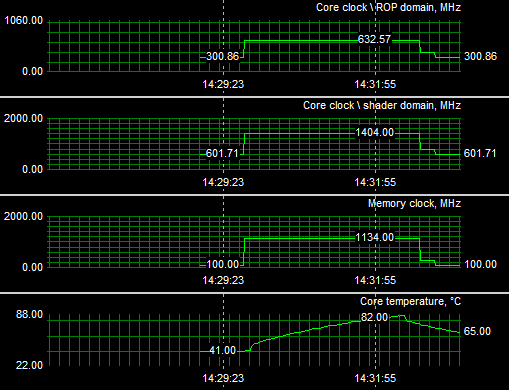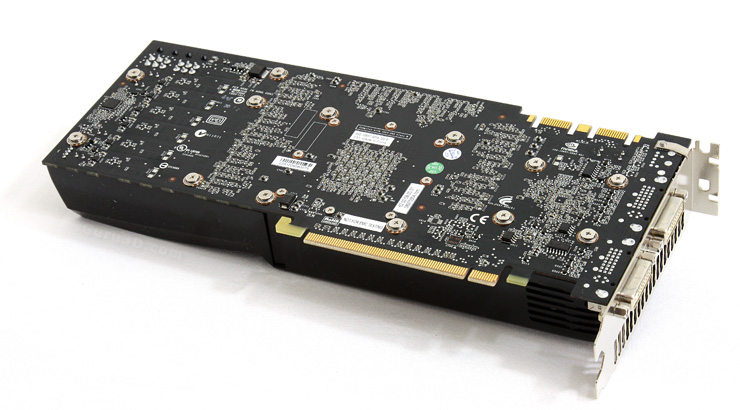Setup | Noise | Power consumption | Heat levels
Setting up the PC
At this stage it is time to insert and connect the graphics card to our test system. Installing the card into your system will be a easy job. Just slide the card into a free PCIe slot, connect the DVI cable to one of the DVI connectors, connect both the 6-pin power connectors to the card.
Especially with a high-end card like this... I do recommend you buy a decent PSU with some reserves, always. The PSU is an extremely important component in your PC. But we'll get into that in a minute.
Once the card is installed, we start up Windows. Install the driver, reboot and you should be good to go. The card will work straight out of the box.

The 6-pin power connectors. The tiny (2-pin) connector is the S/PDIF lead.
Power Consumption
We'll now show you some tests we have done on overall power consumption of the PC.
The methodology is simple: We have a watt monitor constantly monitoring the power draw from the PC. We look at the recorded maximum WATT peak; and that's the bulls-eye you need to observe as the power peak is extremely important. Bear in mind that you are not looking at the power consumption of the graphics card, but the consumption of the entire PC. From a performance versus wattage point of view, the power consumption is pretty good with the new 55nm products.
Note: we recently upgraded our test-platform, which by itself utilizes a lot of energy.
It's Core i7 965 / X58 based and overclocked to 3.7 GHz. Next to that we have energy saving functions disabled for this motherboard and processor (to ensure consistent benchmark results).
The ASUS motherboard also allows adding power phases for stability, which we enabled as well. I'd say on average we are using roughly 50 to 100 Watts more than a standard PC due to these settings and added CPU overclock. Keep that in mind. Our normal system power consumption is much higher than your average system.
- System in IDLE = ~210 Watts
- System with GPU in FULL Stress = ~396 Watts
The monitoring device is reporting a maximum system wattage peak at roughly ~400 Watts, and for a PC with this high-end card, this is excessive but remains within acceptable levels.
The IDLE Wattage is fine, though a little higher than the competition. Again, this test PC consumes heaps of power.
GPU temperatures
So pretty much once we fire off a hefty shader application at the GPU and start monitoring temperature behavior as it would be mid-gaming, we literally stress the GPU 100% with our test. We measured at a room temperature of 21 degrees Celsius.
Now a couple of things are interesting here. Again look at the graph shown below. You should see the P-states we discussed earlier, normally these will save you energy. In 2D mode the GPU tries to save power by lowering clocks & voltages, therefore running at a much lower core frequency.
At idle you can expect a temperature of 40~45 degrees C / 111 F. Pretty normal. Once we push the GPU to 100%, the temperatures take a pretty hefty toll and settle at 80+ Degrees C ~ 179 F. This remains fine within designed operational specifications but it's warm alright.
Though air will be exhausted outside the PC, make sure your PC chassis is well ventilated.

Noise Levels coming from the graphics card
When graphics cards produce a lot of heat, usually that heat needs to be transported away from the hot core as fast as possible. Often you'll see massive active fan solutions that can indeed get rid of the heat, yet all the fans these days make the PC a noisy son of a gun. I'm doing a little try out today with noise monitoring, so basically the test we do is extremely subjective. We bought a certified dBA meter and will start measuring how many dBA originate from the PC. Why is this subjective you ask? Well, there is always noise in the background, from the streets, from the HD, PSU fan etc etc, so this is by a mile or two not a precise measurement. You could only achieve objective measurement in a sound test chamber.
The human hearing system has different sensitivities at different frequencies. This means that the perception of noise is not at all equal at every frequency. Noise with significant measured levels (in dB) at high or low frequencies will not be as annoying as it would be when its energy is concentrated in the middle frequencies. In other words, the measured noise levels in dB will not reflect the actual human perception of the loudness of the noise. That's why we measure the dBA level. A specific circuit is added to the sound level meter to correct its reading in regard to this concept. This reading is the noise level in dBA. The letter A is added to indicate the correction that was made in the measurement. Frequencies below 1kHz and above 6kHz are attenuated, where as frequencies between 1kHz and 6kHz are amplified by the A weighting.
| TYPICAL SOUND LEVELS | ||
| Jet takeoff (200 feet) | 120 dBA | |
| Construction Site | 110 dBA | Intolerable |
| Shout (5 feet) | 100 dBA | |
| Heavy truck (50 feet) | 90 dBA | Very noisy |
| Urban street | 80 dBA | |
| Automobile interior | 70 dBA | Noisy |
| Normal conversation (3 feet) | 60 dBA | |
| Office, classroom | 50 dBA | Moderate |
| Living room | 40 dBA | |
| Bedroom at night | 30 dBA | Quiet |
| Broadcast studio | 20 dBA | |
| Rustling leaves | 10 dBA | Barely audible |
We test the card on dBA levels. Obviously the reference coolers all perform roughly the same. The customized coolers are either louder or softer depending on what they try to achieve.
- So in IDLE mode, you will not hear the card. We measure 39 dBA coming from the PC.
- Gaming with an average title not stressing the GPU too much we can hear the fan a little, we measure roughly 40 dBA.
- When we loop 3DMark Vantage for a while the GPU really heats up, the DBa levels remain really fine though at roughly 41 DBa.
So to sum it up, it's a relatively quiet graphics card, we like that very much.

